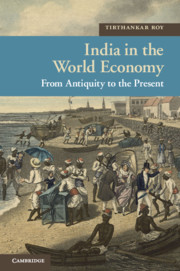Book contents
- Frontmatter
- Contents
- Figures and Tables
- Preface
- 1 Introduction
- 2 Ports and Hinterlands to 1200
- 3 Receding Land Frontiers, 1200–1700
- 4 The Indian Ocean Trade, 1500–1800
- 5 Trade, Migration, and Investment, 1800–1850
- 6 Trade, Migration, and Investment, 1850–1920
- 7 Colonialism and Development, 1860–1920
- 8 Depression and Decolonization, 1920–1950
- 9 From Trade to Aid, 1950–1980
- 10 Return to Market, 1980–2010
- 11 Conclusion
- References
- Index
- References
4 - The Indian Ocean Trade, 1500–1800
Published online by Cambridge University Press: 05 July 2012
- Frontmatter
- Contents
- Figures and Tables
- Preface
- 1 Introduction
- 2 Ports and Hinterlands to 1200
- 3 Receding Land Frontiers, 1200–1700
- 4 The Indian Ocean Trade, 1500–1800
- 5 Trade, Migration, and Investment, 1800–1850
- 6 Trade, Migration, and Investment, 1850–1920
- 7 Colonialism and Development, 1860–1920
- 8 Depression and Decolonization, 1920–1950
- 9 From Trade to Aid, 1950–1980
- 10 Return to Market, 1980–2010
- 11 Conclusion
- References
- Index
- References
Summary
Indo-European trade laid the foundation for a new economic order in Asia and in Europe. Asian goods created new consumer markets in Europe. Asian trade had a formative effect on the world’s money markets. In the eighteenth century, the European desire to maintain the supply of Asian goods contributed to the motivation to colonize. Indo-European trade was also the medium of transmission of new technological knowledge in both directions. There was so much two-way traffic that it would be hard to characterize the effects in terms of a model of European influence on India or an Indian “incorporation” into a European world economy. In any case, the hybrid technological, institutional, and political order that followed had momentous consequences for India. This chapter explores the evolution of Indo-European trade. The discussion leads to larger questions about the meaning of the trade for Indian history.
The Indian Ocean world at 1500
Situated in the middle of the “great arc” of Asian trade, India is geographically well placed to trade with both sides of the Indian Ocean. It was not usual for any one merchant group to connect the extremities of the arc. Direct trade between West Asia and China was not unknown but, always rare, it declined after 1400. One consequence of that decline was the relative expansion of India’s ports as points where cargo could change ships and ships could be restocked with food and water. This development strengthened the segments within the Indian Ocean and brought the West Asian and African ports of Aden, Hormuz, and Kilwa into closer contact with Malacca in Southeast Asia; at the same time, the middleman position of India grew. The Indian ports were more than transit points, however. They were also markets themselves. The extent of India’s land and the diversity of its resources made the ports sources for a variety of textiles, including silk and muslin, and for raw products like rice, sugar, oil, cotton, and indigo. India imported for its own consumption gold and silver, specialized consumer goods, horses, and, for the reexport business, a variety of spices. The spices came from the Indonesian islands to Cambay, to be forwarded to West Asia, and then onward to Europe.
- Type
- Chapter
- Information
- India in the World EconomyFrom Antiquity to the Present, pp. 78 - 122Publisher: Cambridge University PressPrint publication year: 2012

